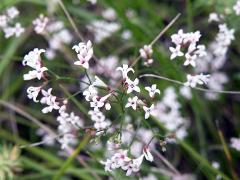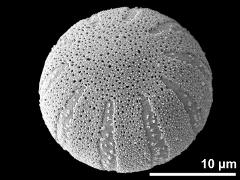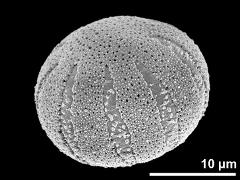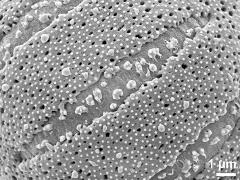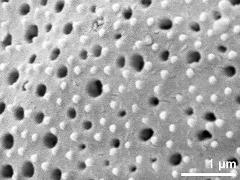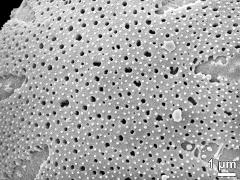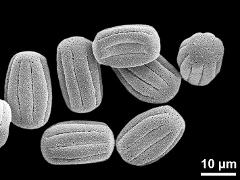Asperula cynanchica
Taxonomy: Spermatophyta, Gentianales, Rubiaceae, Asperula
Published: 2005-06-01
Pollen Description
Shape, Size and Aperture
pollen unit: monad, dispersal unit and peculiarities: monad, size (pollen unit): small (10-25 µm), size of hydrated pollen (LM): -, shortest polar axis in equatorial view (LM): -, longest polar axis in equatorial view (LM): -, shortest diameter in equatorial or polar view (LM): -, longest diameter in equatorial or polar view (LM): -, pollen class: colpate, polarity: isopolar, P/E-ratio: oblate, shape: -, outline in polar view: circular, dominant orientation (LM): -, P/E-ratio (dry pollen): prolate, shape (dry pollen): -, outline in polar view (dry pollen): lobate, infoldings (dry pollen): aperture(s) sunken, aperture number: >6, aperture type: -, aperture condition: colpate, aperture peculiarities: stephanoaperturate, aperture membrane ornamented
Ornamentation and Structure
LM ornamentation LM: -, nexine: -, sexine: -, SEM ornamentation SEM: perforate, microechinate, suprasculpture SEM: -, TEM tectum: eutectate, infratectum: -, foot layer: -, endexine: -, intine: -, wall peculiarities: -, supratectal element: -
Miscellaneous
pollen coatings: absent, reserves in cytoplasm: -, cell number: -, Ubisch bodies: absent
Annotations: number of colpi varying, mostly 8 - 10
Author(s) of diagnosis: Svojtka, M.; Halbritter, H.
Pictures
Picture legend
- flower(s), photographer: Svojtka, M.
- polar view - fresh, rehydrated (water) & critical point dried & sputter coated with gold, photographer: Halbritter, H.
- equatorial view - fresh, rehydrated (water) & critical point dried & sputter coated with gold, photographer: Halbritter, H.
- aperture - fresh, rehydrated (water) & critical point dried & sputter coated with gold, photographer: Halbritter, H.
- exine surface - fresh, rehydrated (water) & critical point dried & sputter coated with gold, photographer: Halbritter, H.
- polar area - fresh, rehydrated (water) & critical point dried & sputter coated with gold, photographer: Halbritter, H.
- dry pollen grains - fresh, sputter coated with gold, photographer: Halbritter, H.
Literature
- (1937) European bee plants and their pollen. Bee Kingdom League, Alexandria, Egypt : 164 pp
- (1984) A practical pollen guide to the British flora. Quaternary Res Bull Technical Guide I: 1-139
- (1929) Die Pollenformen als Mittel zur Honigherkunftbestimmung. Bücherei für Bienenkunde. Karl Wachholtz Verlag, Neumünster in Holstein X: 1-116, 23 pl
- (1975) Elektronenmikroskopische Untersuchungen zur Frage der verwandtschaftlichen Beziehungen zwischen Theligonum und Rubiaceae: Feinbau der Siebelement - Plastiden und Anmerkungen zur Struktur der Pollenexine. Pl Syst Evol 123: 317-326
- (1986) Claves para la determinación de los polenes de las principales especies melíferas de la Península Ibérica. Orsis 2: 27-54
- (1942) Lehrbuch der Pollenanalyse. Handbücher der praktischen Vorgeschichtsforschung. Verlag Ferdinand Enke, Stuttgart 3: 195 pp
- (1942) New Zealand pollen studies. - I. Key to the pollen grains of families and genera in the native flora. Rec Auckland Inst Mus 2: 280-308
- (1987) Agavaceae, Anacardiaceae, Apocynaceae, Arecaceae (Palmae), Asclepiadaceae, Asteraceae (Compositae), Betulaceae, Boraginaceae, Brassicaceae (Cruciferae), Callitrichaceae, Campanulaceae, Capparaceae, Caprifoliaceae, Ceratophyllaceae, Clusiaceae (Guttiferae) In: Valdés B., Díez M.J., Fernández I. (eds) Atlas polínico de Andalucía occidental. Inst de Desarrollo Regional 43, Univ de Sevilla
- (1877) Pollen. Hardwicke & Bogue, London : 92 pp, 24 pl
- (1943) An introduction to pollen analysis. The Ronald Press Company, New York
- (1890) Beiträge zur vergleichenden Morphologie der Pollenkörner. Breslau (Thesis) : 1-72
- (1832) Beiträge zur Kenntnis des Pollen. Berlin, Stettin und Elbing : 48 pp, 2 pl
- (1897) Beiträge zur Biologie und Morphologie des Pollens. Sitzber Böhm Ges Wiss Prag Jahrb XXIII: 1-76
- (1956) Pollen grains of Japan. Hirokawa Publishing Co, Tokyo I-XII: 1-304
- (1978) Pollen dicotyledonearum Florae Partis Europaeae USSR. Lamiaceae - Zygophyllaceae. Nauka, Akad Sci USSR, VL Komarov Inst Bot : 184 pp
- (1834) Über den Bau und die Formen der Pollenkörner. Beiträge zur Anatomie und Physiologie der Gewächse. Erstes Heft. Bern 4: 130 pp, 6 pl
- (1835) Sur la structure et les formes des graines de pollen. Ann Sci Nat, Ser 2 3: 148-180, 220-236, 304-346
- (1978) An illustrated guide to pollen analysis. Hodder & Stoughton Ltd, Kent : 133 pp
- (1992) Pollen et spores d'Europe et d'Afrique du Nord. Laboratoire de Botanique historique et Palynologie, Marseille : 520 pp, 446 pl
- (1973) Palynomorphs of Japanese plants. Spec Publ Osaka Mus Nat Hist 5: 1-60
- (1966) Studiul palinologic al representantilor ordinului Rubiales. Ann Univ Buc Ser Biol 15: 25-57
- (1995) Pollen morphology of Bupleurum L. from Sino-Himalaya and it systematic significance. Chin J Appl Environ Biol 1: 34-43
Copyright and Citation
Cite this publication as:
Svojtka M., Halbritter H. 2005. Asperula cynanchica. In: PalDat - A palynological database. https://www.paldat.org/pub/Asperula_cynanchica/108983;jsessionid=8DFAF64EC7704873BEDA32D1C467B75C; accessed 2024-04-19

